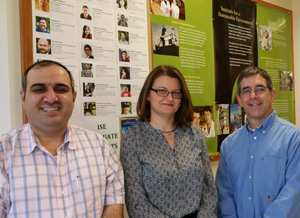Nov 24 2015
A Clarkson University research team has published a paper in a premier environmental sciences and engineering journal about a new technology for measuring bisphenol A (BPA) contamination in the indoor environment.
 From left to right, Clarkson University chemistry graduate student Ramiz Alkasir; Chemistry & Biomolecular Science Professor and Egon Matijevic Chair Silvana Andreescu; and Associate Professor of Environmental Health Science and Associate Director for Education in the Institute for a Sustainable Environment Alan Rossner.
From left to right, Clarkson University chemistry graduate student Ramiz Alkasir; Chemistry & Biomolecular Science Professor and Egon Matijevic Chair Silvana Andreescu; and Associate Professor of Environmental Health Science and Associate Director for Education in the Institute for a Sustainable Environment Alan Rossner.
BPA is a phenolic compound that is used in plastics as a plasticizer, and it is included in products such as drinking bottles, plastic wraps and toys. As a result of leaching, humans can be exposed to BPA by inhalation, ingestion and dermal routes.
Exposure to BPA can potentially lead to behavioral, reproductive, developmental and neurological disorders.
The paper, "Portable Colorimetric Paper-Based Biosensing Device for the Assessment of Bisphenol A in Indoor Dust," appears in American Chemical Society's July 2015 issue of Environmental Science & Technology.
Chemistry & Biomolecular Science Professor and Egon Matijevic Chair Silvana Andreescu; Associate Professor of Environmental Health Science and Associate Director for Education in the Institute for a Sustainable Environment Alan Rossner; and chemistry graduate student Ramiz Alkasir have designed a compact portable colorimetric paper-based biosensing device to assess BPA in indoor dust.
The researchers' system uses interchangeable low-cost, paper-based enzyme sensors as a test zone for BPA detection interfaced as a sample collection area. The sensors are inexpensive, stable and can be mass-produced; and have a detection limit of 0.28ug/g.
Sensor data was gathered by watching for a visual color change and by using image analysis software. The system could be adapted to other chemicals such as volatile organic compounds (VOCs), phthalates and pesticides, and can be used in homes, schools and the work environment.
This new approach for detecting BPA in dust samples provides a low cost alternative to conventional methodologies that are expensive, time consuming and not readily adaptable to field analysis. The system could be particularly useful in large scale exposure assessment and epidemiological studies to establish a spatiotemporal profile of BPA exposure in the living environment.
Clarkson University launches leaders into the global economy. One in five alumni already leads as a CEO, VP or equivalent senior executive of a company. Located just outside the Adirondack Park in Potsdam, N.Y., Clarkson is a nationally recognized research university for undergraduates with select graduate programs in signature areas of academic excellence directed toward the world’s pressing issues. Through 50 rigorous programs of study in engineering, business, arts, sciences and the health professions, the entire learning-living community spans boundaries across disciplines, nations and cultures to build powers of observation, challenge the status quo, and connect discovery and engineering innovation with enterprise.